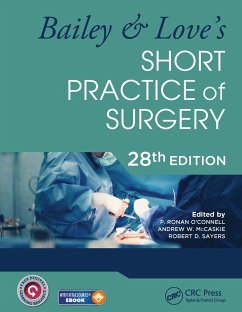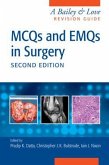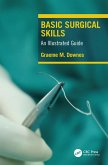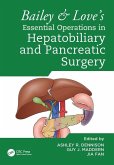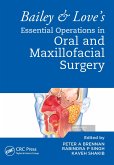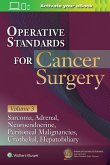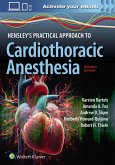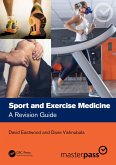Bailey & Love's Short Practice of Surgery - 28th Edition
Herausgeber: McCaskie, Andrew W.; Sayers, Robert D.; O'Connell, P. Ronan
Bailey & Love's Short Practice of Surgery - 28th Edition
Herausgeber: McCaskie, Andrew W.; Sayers, Robert D.; O'Connell, P. Ronan
- Broschiertes Buch
- Merkliste
- Auf die Merkliste
- Bewerten Bewerten
- Teilen
- Produkt teilen
- Produkterinnerung
- Produkterinnerung
The 28th edition of Bailey & Loveâ s Short Practice of Surgery is the leading surgical resource for medical students and surgeons in training. It encompasses the basic principles of careful history taking, observation, deductive reasoning, technical knowledge and post-operative patient care to ensure safe surgical practice.
Andere Kunden interessierten sich auch für
![MCQs and EMQs in Surgery MCQs and EMQs in Surgery]() MCQs and EMQs in Surgery55,99 €
MCQs and EMQs in Surgery55,99 €![Basic Surgical Skills Basic Surgical Skills]() Graeme DownesBasic Surgical Skills44,99 €
Graeme DownesBasic Surgical Skills44,99 €![Bailey & Love's Essential Operations in Hepatobiliary and Pancreatic Surgery Bailey & Love's Essential Operations in Hepatobiliary and Pancreatic Surgery]() Bailey & Love's Essential Operations in Hepatobiliary and Pancreatic Surgery136,99 €
Bailey & Love's Essential Operations in Hepatobiliary and Pancreatic Surgery136,99 €![Bailey & Love's Essential Operations in Oral & Maxillofacial Surgery Bailey & Love's Essential Operations in Oral & Maxillofacial Surgery]() Bailey & Love's Essential Operations in Oral & Maxillofacial Surgery136,99 €
Bailey & Love's Essential Operations in Oral & Maxillofacial Surgery136,99 €![Operative Standards for Cancer Surgery: Volume 3 Operative Standards for Cancer Surgery: Volume 3]() AMERICAN COLLEGE OF SURGEONS CANCER RESEARCH PROGRAMOperative Standards for Cancer Surgery: Volume 381,99 €
AMERICAN COLLEGE OF SURGEONS CANCER RESEARCH PROGRAMOperative Standards for Cancer Surgery: Volume 381,99 €![Hensley's Practical Approach to Cardiothoracic Anesthesia: Print + eBook with Multimedia Hensley's Practical Approach to Cardiothoracic Anesthesia: Print + eBook with Multimedia]() Karsten BartelsHensley's Practical Approach to Cardiothoracic Anesthesia: Print + eBook with Multimedia81,99 €
Karsten BartelsHensley's Practical Approach to Cardiothoracic Anesthesia: Print + eBook with Multimedia81,99 €![Sport and Exercise Medicine Sport and Exercise Medicine]() Sport and Exercise Medicine63,99 €
Sport and Exercise Medicine63,99 €-
-
-
The 28th edition of Bailey & Loveâ s Short Practice of Surgery is the leading surgical resource for medical students and surgeons in training. It encompasses the basic principles of careful history taking, observation, deductive reasoning, technical knowledge and post-operative patient care to ensure safe surgical practice.
Hinweis: Dieser Artikel kann nur an eine deutsche Lieferadresse ausgeliefert werden.
Hinweis: Dieser Artikel kann nur an eine deutsche Lieferadresse ausgeliefert werden.
Produktdetails
- Produktdetails
- Verlag: Taylor & Francis Ltd
- 28 ed
- Seitenzahl: 1676
- Erscheinungstermin: 30. März 2023
- Englisch
- Abmessung: 274mm x 215mm x 67mm
- Gewicht: 4364g
- ISBN-13: 9780367548117
- ISBN-10: 0367548119
- Artikelnr.: 67767176
- Herstellerkennzeichnung
- Libri GmbH
- Europaallee 1
- 36244 Bad Hersfeld
- gpsr@libri.de
- Verlag: Taylor & Francis Ltd
- 28 ed
- Seitenzahl: 1676
- Erscheinungstermin: 30. März 2023
- Englisch
- Abmessung: 274mm x 215mm x 67mm
- Gewicht: 4364g
- ISBN-13: 9780367548117
- ISBN-10: 0367548119
- Artikelnr.: 67767176
- Herstellerkennzeichnung
- Libri GmbH
- Europaallee 1
- 36244 Bad Hersfeld
- gpsr@libri.de
Professor P. Ronan O'Connell, BA MD FRCSI FRCSGlasg FRCSEd FRCSEng (Hon) FCSHK(Hon) - President, Royal College of Surgeons in Ireland; President, European Surgical Association; Emeritus Professor of Surgery, University College Dublin, Dublin, Ireland Professor O'Connell has served as an editor of the British Journal of Surgery and associate editor of Diseases of the Colon and Rectum. He has been editor in chief for the European Surgical Association and joint editor of Bailey and Love's Short Practice of Surgery for the 25th, 26th 27th and now 28th editions, having contributed chapters to the 23rd and 24th editions. Apart from his editing, Prof O'Connell is widely published in the areas of IBD, colorectal cancer and pelvic floor physiology. He is a Council member of the Royal College of Surgeons in Ireland and holds ad hominum fellowships of the Glasgow and Edinburgh Royal Colleges. He is a past President of the European Society of Coloproctology and honorary fellow of the American Surgical Association and the American Society of Colon and Rectal Surgeons. Professor Andrew W. McCaskie, MMus MD FRCS FRCSENG (Tr and Orth) - Professor of Orthopaedic Surgery and Head of Department of Surgery; University of Cambridge, Honorary Consultant, Addenbrooke's Hospital, Cambridge University Hospitals NHS Foundation Trust, Cambridge, UK Professor Andrew McCaskie is Professor of Orthopaedic Surgery and Head of Department of Surgery at the University of Cambridge. He trained in Leeds, Leicester and Newcastle upon Tyne, where he was Professor of Orthopaedic Surgery until moving to Cambridge in 2013. His clinical interest is the lower limb, and particularly the treatment of osteoarthritis, seeking to develop repair and regenerative therapies at early stages of disease. He is the Director of the Arthritis Research UK Tissue Engineering Centre which brings together UK clinicians, engineers and biologists to develop stem and stromal cell therapy for early osteoarthritis. He has been the President of the British Orthopaedic Research Society, member of the Council of Management of The British Editorial Society of Bone and Joint Surgery, and member of Council of the British Orthopaedic Association. He is currently the Director of the Academic Foundation Programme in Cambridge and is widely published, including papers in The Lancet and Nature Genetics. Professor Robert D Sayers, MBChB(Hons) MD AFHEA FRCSEng - George Davies Chair of Vascular Surgery, University of Leicester and Glenfield Hospital, Leicester, UK Member of the Court of Examiners, Royal College of Surgeons of England. Royal College of Surgeons Surgical Tutor, Leicester Royal Infirmary. Member of the Critical Care Steering Group, Royal College of Surgeons of England.
PART ONE: BASIC PRINCIPLES . Metabolic response to injury. Shock,
haemorrhage and transfusion. Wound healing and tissue repair. Tissue
engineering and regenerative Therapies. Surgical infection. Tropical
infections and infestations. Basic surgical skills. Diagnostic imaging.
Gastrointestinal endoscopy. Principles of minimal access surgery.
Principles of oncology. Surgical audit and research. Ethics and law in
surgical practice. Human factors, patient safety and quality improvement.
Global Health and surgery. PART TWO: GENERAL PAEDIATRICS. Paediatric
surgery.Neonatal Surgery. Trauma in children. Paediatric Urology. PART
THREE: PERIOPERATIVE CARE Pre-operative care including the high-risk
patient. Day case surgery. Anaesthesia and pain relief. Post-operative care
including perioperative optimisation.Nutrition and fluid therapy PART FOUR:
TRAUMA Introduction to trauma. Early assessment and management of sever
trauma. Traumatic brain injury. Torso and pelvic trauma. The neck and
spine. Maxillofacial trauma. Extremity trauma. Disaster surgery. Conflict
Surgery. PART FIVE: ELECTIVE ORTHOPAEDICS History taking and clinical
examination in musculoskeletal disease. Sports medicine and sports
injuries. The spine. The upper limb. The hip. The knee. The foot and ankle.
Musculoskeletal tumours. Infection of the bones and joints. Paediatric
orthopaedics PART SIX: SKIN, PLASTIC and RECONSTRUCTIVE Skin and
subcutaneous tissue. Burns. Plastic and reconstructive surgery PART SEVEN:
HEAD AND NECK Cranial Neurosurgery. The eye and orbit. Developmental
abnormalities of the face mouth and jaws: cleft lip & palate. The ear, nose
and sinuses. The pharynx, larynx and neck. Oral cavity cancer. Disorders of
the salivary glands PART EIGHT: ENDOCRINE and BREAST. The thyroid gland.
The parathyroid glands.The adrenal glands and other abdominal endocrine
disorders. The breast. PART NINE: CARDIOTHORACIC Cardiac surgery. The
thorax PART TEN: VASCULAR Arterial disorders. Venous disorders.Lymphatic
Disorders. PART ELEVEN: ABDOMINAL History and examination of the abdomen.
The abdominal wall, hernia and umbilicus. The peritoneum, mesentery,
greater omentum and retroperitoneal space. The oesophagus. The stomach and
duodenum. Bariatric and metabolic surgery. The liver. The spleen. The gall
bladder and bile ducts. The pancreas. Functional disorders of the
intestine. The small intestines. Inflammatory bowel disease. The vermiform
appendix. The large intestine. Intestinal obstruction. The rectum. The anus
and anal canal. PART TWELVE: GENITOURINARY Urinary symptoms and
investigations. The kidney and ureter. The urinary bladder. The prostate
and seminal vesicles. The urethra and penis. The testis and scrotum.
Gynaecology. PART THIRTEEN: TRANSPLANTATION Kidney transplantation and the
principles of transplantation. Liver transplantation. Pancreas
transplantation. Intestinal and multivisceral transplantation.
haemorrhage and transfusion. Wound healing and tissue repair. Tissue
engineering and regenerative Therapies. Surgical infection. Tropical
infections and infestations. Basic surgical skills. Diagnostic imaging.
Gastrointestinal endoscopy. Principles of minimal access surgery.
Principles of oncology. Surgical audit and research. Ethics and law in
surgical practice. Human factors, patient safety and quality improvement.
Global Health and surgery. PART TWO: GENERAL PAEDIATRICS. Paediatric
surgery.Neonatal Surgery. Trauma in children. Paediatric Urology. PART
THREE: PERIOPERATIVE CARE Pre-operative care including the high-risk
patient. Day case surgery. Anaesthesia and pain relief. Post-operative care
including perioperative optimisation.Nutrition and fluid therapy PART FOUR:
TRAUMA Introduction to trauma. Early assessment and management of sever
trauma. Traumatic brain injury. Torso and pelvic trauma. The neck and
spine. Maxillofacial trauma. Extremity trauma. Disaster surgery. Conflict
Surgery. PART FIVE: ELECTIVE ORTHOPAEDICS History taking and clinical
examination in musculoskeletal disease. Sports medicine and sports
injuries. The spine. The upper limb. The hip. The knee. The foot and ankle.
Musculoskeletal tumours. Infection of the bones and joints. Paediatric
orthopaedics PART SIX: SKIN, PLASTIC and RECONSTRUCTIVE Skin and
subcutaneous tissue. Burns. Plastic and reconstructive surgery PART SEVEN:
HEAD AND NECK Cranial Neurosurgery. The eye and orbit. Developmental
abnormalities of the face mouth and jaws: cleft lip & palate. The ear, nose
and sinuses. The pharynx, larynx and neck. Oral cavity cancer. Disorders of
the salivary glands PART EIGHT: ENDOCRINE and BREAST. The thyroid gland.
The parathyroid glands.The adrenal glands and other abdominal endocrine
disorders. The breast. PART NINE: CARDIOTHORACIC Cardiac surgery. The
thorax PART TEN: VASCULAR Arterial disorders. Venous disorders.Lymphatic
Disorders. PART ELEVEN: ABDOMINAL History and examination of the abdomen.
The abdominal wall, hernia and umbilicus. The peritoneum, mesentery,
greater omentum and retroperitoneal space. The oesophagus. The stomach and
duodenum. Bariatric and metabolic surgery. The liver. The spleen. The gall
bladder and bile ducts. The pancreas. Functional disorders of the
intestine. The small intestines. Inflammatory bowel disease. The vermiform
appendix. The large intestine. Intestinal obstruction. The rectum. The anus
and anal canal. PART TWELVE: GENITOURINARY Urinary symptoms and
investigations. The kidney and ureter. The urinary bladder. The prostate
and seminal vesicles. The urethra and penis. The testis and scrotum.
Gynaecology. PART THIRTEEN: TRANSPLANTATION Kidney transplantation and the
principles of transplantation. Liver transplantation. Pancreas
transplantation. Intestinal and multivisceral transplantation.
PART ONE: BASIC PRINCIPLES . Metabolic response to injury. Shock,
haemorrhage and transfusion. Wound healing and tissue repair. Tissue
engineering and regenerative Therapies. Surgical infection. Tropical
infections and infestations. Basic surgical skills. Diagnostic imaging.
Gastrointestinal endoscopy. Principles of minimal access surgery.
Principles of oncology. Surgical audit and research. Ethics and law in
surgical practice. Human factors, patient safety and quality improvement.
Global Health and surgery. PART TWO: GENERAL PAEDIATRICS. Paediatric
surgery.Neonatal Surgery. Trauma in children. Paediatric Urology. PART
THREE: PERIOPERATIVE CARE Pre-operative care including the high-risk
patient. Day case surgery. Anaesthesia and pain relief. Post-operative care
including perioperative optimisation.Nutrition and fluid therapy PART FOUR:
TRAUMA Introduction to trauma. Early assessment and management of sever
trauma. Traumatic brain injury. Torso and pelvic trauma. The neck and
spine. Maxillofacial trauma. Extremity trauma. Disaster surgery. Conflict
Surgery. PART FIVE: ELECTIVE ORTHOPAEDICS History taking and clinical
examination in musculoskeletal disease. Sports medicine and sports
injuries. The spine. The upper limb. The hip. The knee. The foot and ankle.
Musculoskeletal tumours. Infection of the bones and joints. Paediatric
orthopaedics PART SIX: SKIN, PLASTIC and RECONSTRUCTIVE Skin and
subcutaneous tissue. Burns. Plastic and reconstructive surgery PART SEVEN:
HEAD AND NECK Cranial Neurosurgery. The eye and orbit. Developmental
abnormalities of the face mouth and jaws: cleft lip & palate. The ear, nose
and sinuses. The pharynx, larynx and neck. Oral cavity cancer. Disorders of
the salivary glands PART EIGHT: ENDOCRINE and BREAST. The thyroid gland.
The parathyroid glands.The adrenal glands and other abdominal endocrine
disorders. The breast. PART NINE: CARDIOTHORACIC Cardiac surgery. The
thorax PART TEN: VASCULAR Arterial disorders. Venous disorders.Lymphatic
Disorders. PART ELEVEN: ABDOMINAL History and examination of the abdomen.
The abdominal wall, hernia and umbilicus. The peritoneum, mesentery,
greater omentum and retroperitoneal space. The oesophagus. The stomach and
duodenum. Bariatric and metabolic surgery. The liver. The spleen. The gall
bladder and bile ducts. The pancreas. Functional disorders of the
intestine. The small intestines. Inflammatory bowel disease. The vermiform
appendix. The large intestine. Intestinal obstruction. The rectum. The anus
and anal canal. PART TWELVE: GENITOURINARY Urinary symptoms and
investigations. The kidney and ureter. The urinary bladder. The prostate
and seminal vesicles. The urethra and penis. The testis and scrotum.
Gynaecology. PART THIRTEEN: TRANSPLANTATION Kidney transplantation and the
principles of transplantation. Liver transplantation. Pancreas
transplantation. Intestinal and multivisceral transplantation.
haemorrhage and transfusion. Wound healing and tissue repair. Tissue
engineering and regenerative Therapies. Surgical infection. Tropical
infections and infestations. Basic surgical skills. Diagnostic imaging.
Gastrointestinal endoscopy. Principles of minimal access surgery.
Principles of oncology. Surgical audit and research. Ethics and law in
surgical practice. Human factors, patient safety and quality improvement.
Global Health and surgery. PART TWO: GENERAL PAEDIATRICS. Paediatric
surgery.Neonatal Surgery. Trauma in children. Paediatric Urology. PART
THREE: PERIOPERATIVE CARE Pre-operative care including the high-risk
patient. Day case surgery. Anaesthesia and pain relief. Post-operative care
including perioperative optimisation.Nutrition and fluid therapy PART FOUR:
TRAUMA Introduction to trauma. Early assessment and management of sever
trauma. Traumatic brain injury. Torso and pelvic trauma. The neck and
spine. Maxillofacial trauma. Extremity trauma. Disaster surgery. Conflict
Surgery. PART FIVE: ELECTIVE ORTHOPAEDICS History taking and clinical
examination in musculoskeletal disease. Sports medicine and sports
injuries. The spine. The upper limb. The hip. The knee. The foot and ankle.
Musculoskeletal tumours. Infection of the bones and joints. Paediatric
orthopaedics PART SIX: SKIN, PLASTIC and RECONSTRUCTIVE Skin and
subcutaneous tissue. Burns. Plastic and reconstructive surgery PART SEVEN:
HEAD AND NECK Cranial Neurosurgery. The eye and orbit. Developmental
abnormalities of the face mouth and jaws: cleft lip & palate. The ear, nose
and sinuses. The pharynx, larynx and neck. Oral cavity cancer. Disorders of
the salivary glands PART EIGHT: ENDOCRINE and BREAST. The thyroid gland.
The parathyroid glands.The adrenal glands and other abdominal endocrine
disorders. The breast. PART NINE: CARDIOTHORACIC Cardiac surgery. The
thorax PART TEN: VASCULAR Arterial disorders. Venous disorders.Lymphatic
Disorders. PART ELEVEN: ABDOMINAL History and examination of the abdomen.
The abdominal wall, hernia and umbilicus. The peritoneum, mesentery,
greater omentum and retroperitoneal space. The oesophagus. The stomach and
duodenum. Bariatric and metabolic surgery. The liver. The spleen. The gall
bladder and bile ducts. The pancreas. Functional disorders of the
intestine. The small intestines. Inflammatory bowel disease. The vermiform
appendix. The large intestine. Intestinal obstruction. The rectum. The anus
and anal canal. PART TWELVE: GENITOURINARY Urinary symptoms and
investigations. The kidney and ureter. The urinary bladder. The prostate
and seminal vesicles. The urethra and penis. The testis and scrotum.
Gynaecology. PART THIRTEEN: TRANSPLANTATION Kidney transplantation and the
principles of transplantation. Liver transplantation. Pancreas
transplantation. Intestinal and multivisceral transplantation.

